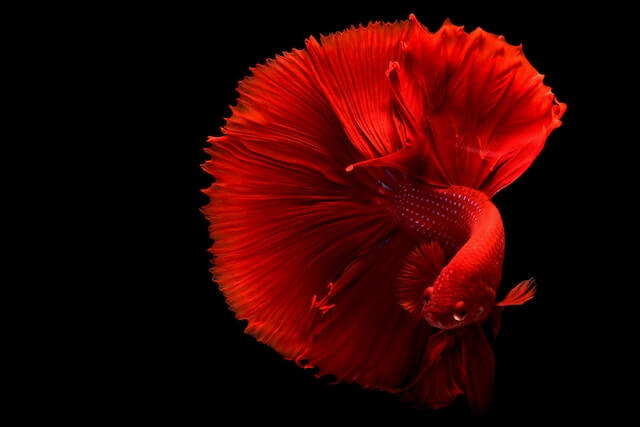How often should you feed a Halfmoon betta?

The Halfmoon betta, also known as the Siamese fighting fish, is a beautiful and vibrant creature that has captured the hearts of many fish enthusiasts. With its stunning colorful fins and unique semi-circular tail shape, it is no wonder why people are drawn to this species. However, as a responsible betta owner, it is important to know how often to feed these fish to ensure their optimal health and well-being. While it may be tempting to overfeed these little beauties, it is essential to strike the right balance between providing enough sustenance and avoiding potential health issues such as obesity.
In this article, we will explore the feeding habits of the Halfmoon betta, discussing the recommended frequency and quantity of their meals, as well as some essential tips for maintaining a healthy diet for these magnificent creatures.
Understanding the dietary needs of a Halfmoon betta fish
Understanding the dietary needs of a Halfmoon Betta Fish is crucial for their overall health and well-being. These beautiful creatures require a balanced and nutritious diet to thrive in captivity. Proper nutrition is essential in supporting their vibrant colors, strong immune system, and overall vitality. It is important to note that a varied diet is necessary to meet their dietary requirements, replicating their natural feeding habits in the wild.
Betta fish are primarily carnivorous. In the wild, they consume small insects, larvae, and crustaceans. Therefore, a staple diet of high-quality betta pellets or flakes that contain a high percentage of animal protein is recommended. These pellets should be the mainstay of their diet, providing essential nutrients and vitamins that promote growth and vitality.
In addition to pellets, it is crucial to provide these fish with a variety of frozen or live foods to mimic their natural diet. These can include bloodworms, brine shrimp, daphnia, and mosquito larvae. Frozen foods are typically more accessible and convenient to store, while live foods can provide additional enrichment and mental stimulation for the fish.
Factors to consider in determining feeding frequency
A. Age and size of the betta fish:
The age and size of a betta fish are important factors to consider when deciding how often to feed them. Younger betta fish tend to have faster metabolisms and require more frequent feedings, while older bettas may have slower metabolisms and can be fed less often. Additionally, the size of the betta fish plays a role in determining feeding frequency. Smaller fish may need to eat more often than larger fish to meet their nutritional needs.
B. Activity level and metabolism:
The activity level and metabolism of a betta fish can vary greatly between individuals. Some bettas are more active and have higher metabolic rates, which means they require more frequent feedings to sustain their energy levels. On the other hand, more sedentary bettas may not need to eat as often. Observing the behavior and activity level of your betta fish can help you determine the appropriate feeding frequency for them.
C. Water temperature and quality:
The water temperature and quality in the betta fish’s environment can also impact their feeding frequency. Warmer water temperatures tend to increase the metabolism of bettas, leading to an increased need for food. It is important to note that bettas are tropical fish and thrive in water temperatures between 76-82°F (24-28°C). Additionally, bettas are sensitive to poor water quality, which can affect their appetite. Regularly testing and maintaining water quality parameters, such as ammonia and nitrate levels, will ensure a healthy appetite and proper feeding frequency for your betta fish.
Feeding frequency guidelines for betta fish
Determining the appropriate feeding frequency for your betta fish is crucial for their overall health and well-being. While there are general guidelines to follow, it is important to remember that each betta is unique, and their individual needs may vary.
For young and growing bettas, it is recommended to feed them small, frequent meals throughout the day. Aim for about twice feedings per day, with each meal consisting of only a few pellets or flakes. This ensures that they receive enough nutrients and energy to support their growth and development.
Adult bettas, on the other hand, can typically be fed once a day. This feeding schedule is suitable for bettas that have reached their full size and have stable metabolic rates. It is important not to overfeed adult bettas as this can lead to obesity and other health issues. Remember to only give them a small amount of food during each feeding, enough for them to consume within a few minutes.
In addition to regular feedings, it is important to incorporate a variety of foods into a betta’s diet to ensure they receive a balanced and nutritious meal. Consider alternating between high-quality betta pellets, freeze-dried or frozen foods such as bloodworms or brine shrimp, and occasionally offering live foods like daphnia. This variety helps mimic their natural diet and provides them with essential nutrients.
Observing your betta fish’s behavior and body condition is crucial in determining if the feeding frequency and amount are appropriate. Over time, you will become familiar with your betta’s feeding habits and adjust accordingly to ensure they remain healthy and active.
Conclusion
Feeding frequency plays a crucial role in the overall health and well-being of a Halfmoon betta. While it is important to offer a varied diet and keep track of portion sizes, it is equally important to find a feeding schedule that works best for the individual fish. Daily feeding is generally recommended, but some bettas may thrive on a slightly less frequent schedule. By observing their behavior and adjusting their feeding regimen accordingly, betta owners can ensure that their Halfmoon bettas are receiving the nutrition they need to thrive. Remember, moderation is key, and a healthy and balanced diet will lead to a happy and vibrant betta.
Passionate Writer, Blogger and Amazon Affiliate Expert since 2014.




























